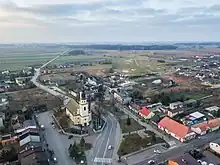Parzęczew | |
|---|---|
City | |
.jpg.webp) Parish church of Virgin Mary, built 1804-1810. | |
 Parzęczew | |
| Coordinates: 51°56′26″N 19°12′20″E / 51.94056°N 19.20556°E | |
| Country | |
| Voivodeship | Łódź |
| County | Zgierz |
| Gmina | Parzęczew |
| Population | |
| • Total | 914 |
| Time zone | UTC+1 (CET) |
| • Summer (DST) | UTC+2 (CEST) |
| Vehicle registration | EZG |
Parzęczew [paˈʐɛnt͡ʂɛf] is a city in Zgierz County, Łódź Voivodeship, in central Poland. It is the seat of the gmina (administrative district) called Gmina Parzęczew. It lies approximately 18 kilometres (11 mi) north-west of Zgierz and 26 km (16 mi) north-west of the regional capital Łódź.[1]
History
.jpg.webp)
Parzęczew was originally a ducal village, on the stream called Gnida, founded by the Pomian family who came from Greater Poland. The first mention of Parzęczew dates back to 1385. In 1421, Parzęczew received town rights under a privilege issued by King Władysław II Jagiełło, as a private town of Wojciech Parzęczewski, a hunter from Łęczyca. Despite repeated confirmation of privileges by successive monarchs, the peripheral town did not develop into a larger center, probably never exceeding the number of 1,000 inhabitants.
It was annexed by Prussia in the Second Partition of Poland in 1793. In 1807, it was regained by Poles and included within the short-lived Duchy of Warsaw. After its dissolution in 1815, Parzęczew fell to the Russian Partition of Poland. Parzęczew's town rights were revoked in 1870 under the Tsar's administrative reform. After World War I, Poland regained independence and control of Parzęczew.

Following the joint German-Soviet invasion of Poland, which started World War II in September 1939, Parzęczew was occupied by Germany, and annexed into the Third Reich. In 1941–1942, the German gendarmerie carried out expulsions of Poles, whose houses and farms were then handed over to new German colonists as part of the Lebensraum policy.[2] The Poles were soon enslaved as forced labour and either sent to Germany, German-occupied France or Austria or to German colonists in the county.[2] The Jewish community, traditionally constituting an important part of the population of Parzęczew, was murdered in the Holocaust, and the wooden synagogue from the 18th century was destroyed. In 1943 the name of the village was changed to Parnstädt in attempt to erase traces of Polish origin. Soviet troops occupied Parzęczew on 19 January 1945, and afterwards it was restored to Poland.
In 1975–1998, the town was located in the then Łódź Voivodeship.
To this day, Parzęczew has retained the foundations of the urban spatial layout with a rectangular market square, in the center of which there is a church founded at the beginning of the 19th century by the Stokowski family, and small-town buildings around.
Ryszard Nowakowski has been the mayor of Parzęczew since 2002.[3] As of 2022, the village had a population of 914.[4]
References
- ↑ "Central Statistical Office (GUS) - TERYT (National Register of Territorial Land Apportionment Journal)" (in Polish). 2008-06-01.
- 1 2 Wardzyńska, Maria (2017). Wysiedlenia ludności polskiej z okupowanych ziem polskich włączonych do III Rzeszy w latach 1939-1945 (in Polish). Warszawa: IPN. pp. 309–310, 328. ISBN 978-83-8098-174-4.
- ↑ "25-lecie Samorządu 1990-2015". www.slideshare.net. Retrieved 2023-07-31.
- ↑ "GUS - Bank Danych Lokalnych". bdl.stat.gov.pl. Retrieved 2023-07-31.
